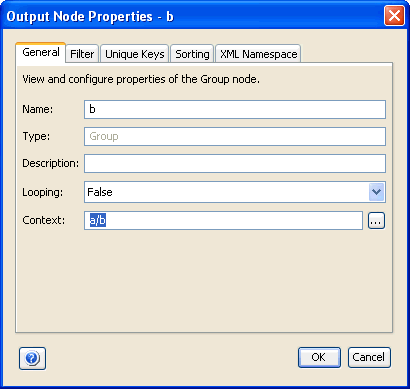To set the context property:
- Create a new Transform project.
- Import a Transform Template (.xch) file.
- Load the Input Structure.
- Click the Mappings tab.
-
Click Test
Transform to view the output.
Group b has child element c with mapping path set to a/b/c.
This path has two "b" group loop iterations in the input. These iterations are different because the values for the attribute, "name," are different.
By default, Transformer’s engine does not recognize that the "b" group loop iterations are different. These iterations are treated as the same because their path location in the document, noted as “a/b”, is the same. To avoid an unexpected result, you must specify that the input node (“a/b”) has different loop instances by setting the "Context" property of the group node.
-
Right-click
the b group node and select Properties.
The Output Node Properties dialog box opens.

-
In the
Context field, specify the path value for the looping node on the input
side, which is a/b.
With these settings you are specifying the looping order for the Transformer’s engine to produce the output tree structure correctly. iWay Transformer’s engine is now aware which "c" node belongs to which "b" node in the context of their loop instances.